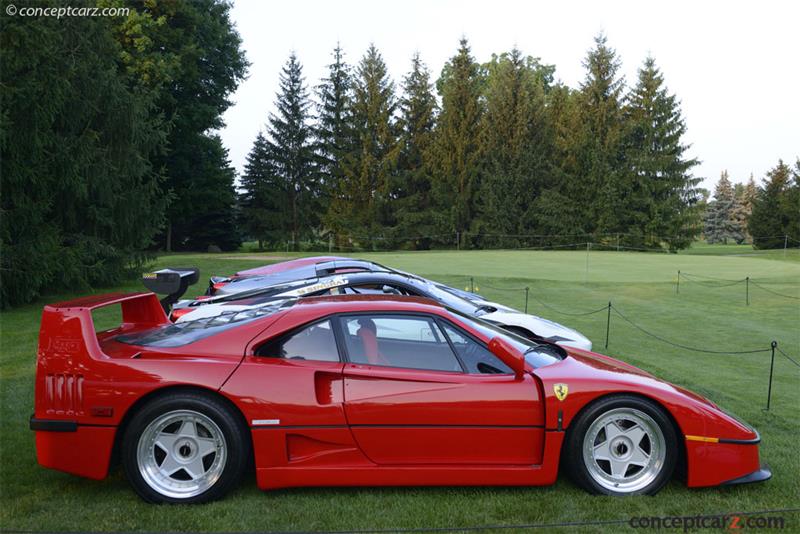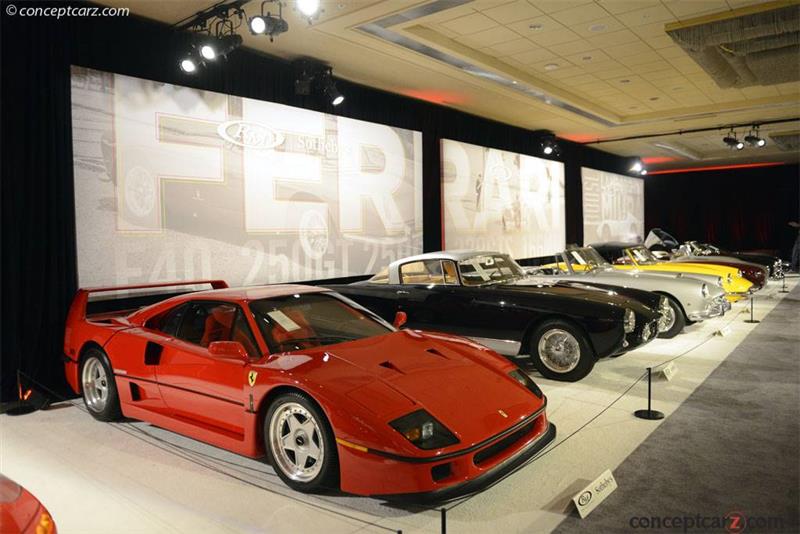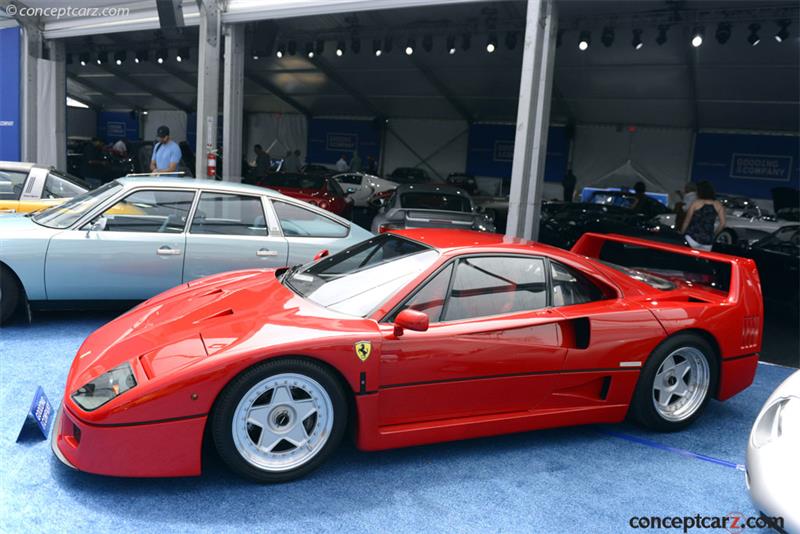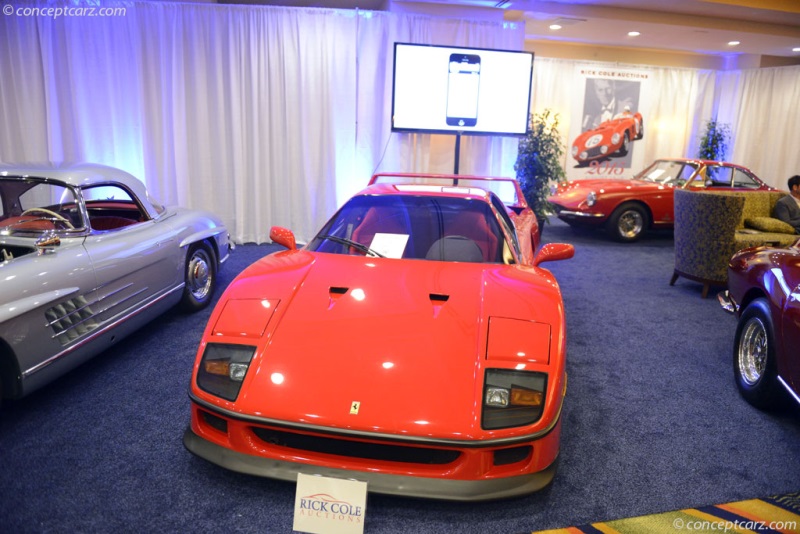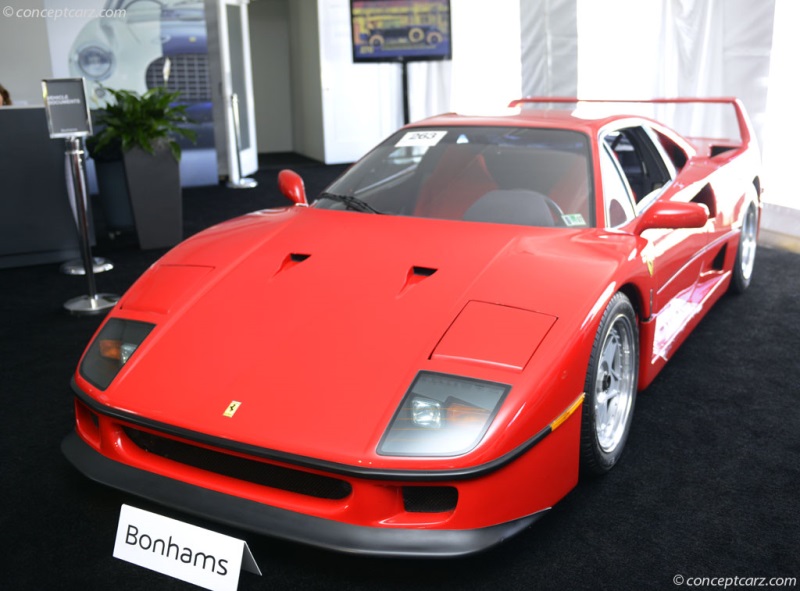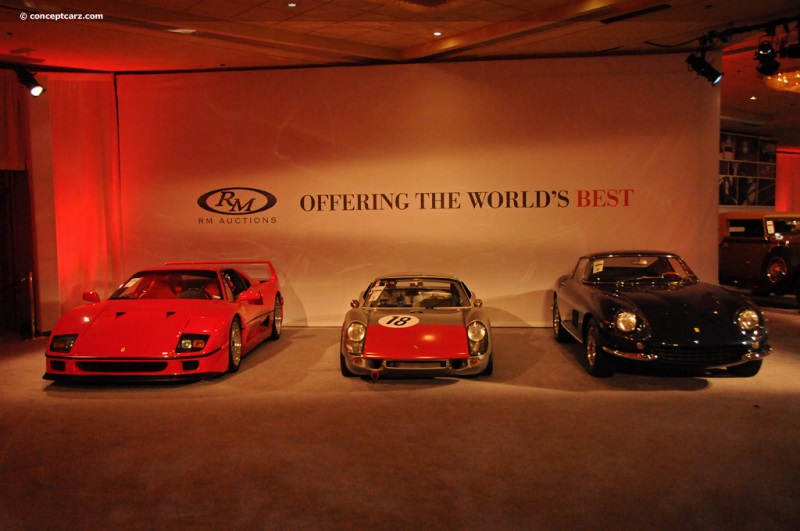The Ferrari F40 was the first of Maranello's special anniversary models and the final supercar built under the supervision of the maestro himself, Enzo Ferrari. It was designed as a lightweight race-capable road-going machine with minimal frills or creature comforts. The dual-use supercar began its existence as an evolution of the twin-turbocharged V-8 powered 288 GTO, itself an extension of the highly developed 308 model line. The composite result of refined engineering was a breathtaking new supercar that delivered equally impressive performance. Sixty MPH was achieved from a standstill in 3.8 seconds en route to a top speed of 201 mph. 
Coupe
Chassis #: ZFFMN34A9M0087511
Engine #: 04561
Auction entries : 1Ferrari unveiled the F40 on July 21, 1987, at the Civic Center in Maranello, just thirteen months after the project's incipit (June of 1986). The presentation was intended to happen at the Frankfurt Motorshow but FIAT needed to present the Alfa Romeo 164 at that show, and the two would have clashed.Initially intended to compete in Group B international competition as a more evolved 288 GTO, only a few examples of the 288 Evoluzione examples were built and tested before the racing series was canceled. So instead, Ferrari used the mule as the basis for a new 40th-anniversary model. Production quickly extended beyond the initially planned 400 examples, eventually constructing 1,315 cars worldwide. Of those, 213 were sent to the United States with standard air conditioning and catalytic converters. Eventually replaced by the F50 and the Enzo, the F40 continued to occupy an echelon above its successors, perhaps attributed to its identity as the original Ferrari commemorative model, the most race-engineered of them all, and the one that most quintessentially embodies the factory's original build values.The suggested retail price in 1987 was approximately US$400,000, which made it approximately five times that of the preceding 288 GTO. It did little to squelch demand, with many examples changing hands at the height of the late 1980s supercar boom for many times the list price. Production ceased in 1992, and each of the 1,315 examples had been built with left-hand drive and finished in Rosso Corsa when they left the factory. At least seven examples were modified and delivered to the Sultan of Brunei in right-hand drive
Coupe
Chassis #: ZFFMN34A0M0089888
View info and history
Auction entries : 1The Ferrari F40 was the last great 'analogue' supercar, built at a time when the driver was expected to be in full control and before the introduction of electronic interventions in the form of traction control, stability control, anti-lock brakes, and paddle-shift automatic gearboxes. It was devoid of a brake servo, power steering, interior door handles, and air conditioning. Ferrari's marketing executive Giovanni Perfetti explained, 'We wanted it to be very fast, sporting in the extreme and Spartan. Customers had been saying our cars were becoming too plush and comfortable. The F40 is for the most enthusiastic of our owners who want nothing but sheer performance.' By the time production of the F40 concluded, it had succumbed to several technological improvements, gaining refinements such as ABS, catalytic converters, and adjustable suspension as development progressed.The F40 was the final Ferrari to use forced induction until the arrival of the California T in 2014.Specification
Displacing 2,936 cubic centimeters (2.9-liter / 179.2 cubic-inch) and fitted with twin IHI turbochargers and Behr intercoolers, the mid-mounted engine developed a stout 478 horsepower at 7,000 RPM and 425 pound-feet of torque at 4,000 RPM. It had a bore size of 82 mm, a stroke of 69.5 mm, 7.7:1 compression, and a unitary displacement of 367 cc. There were dual overhead camshafts per bank, four valves per cylinder, and Weber-Marelli electronic fuel injection with single spark plug ignition per cylinder. Exhaust gases exited each bank of cylinders via flanking exhaust pipes, and a central pipe dispersed gases released from the wastegate of the turbochargers. A catalytic converter was installed in 1990 to comply with U.S. regulations for emissions control reasons.
CoupeThe longitudinally-mounted, rear mid-placed engine was paired to a five-speed manual transmission with a twin-plate clutch and powered the rear wheels. Installed within a race-developed steel tubular space-frame chassis, the wheelbase measured 96.5 inches, had a width of 77.6 inches, an overall length of 171.6 inches, and stood 44.3 inches tall. The four-wheel double-wishbone independent suspension was similar to the GTOs with Koni coil-over shock absorbers, and braking was via four-caliper ventilated discs. Due to the low ground clearance, Ferrari added hydraulic lift chambers in the front dampers to later-built cars to raise the vehicle when necessary. Steering was by a rack and pinion system.The specially designed tires (235/45 ZR 17 or 245/40 ZR 17 at the front and 335/35 ZR 17 at the rear) were built to cope with the additional 80 horsepower produced by the F40, compared to the 288 GTO. Chief engineer Nicola Materazzi worked with the Pirelli head of development Mario Mezzanotte in creating these unique tires, built to near Formula 1 specification, with asymmetrical tread patterns, wide measurements, and the ability to handle extreme starts and speeds. Bodywork and Interior
The angular bodywork was penned by Pietro Camardella under supervision by Pininfarina's stylists Leonardo Fioravanti and Aldo Brovarone, and aerodynamically perfected in Pininfarina's wind tunnel. It featured a massive spoiler wing that was a consummate study in 1980s wedge angularity. Through extensive wind tunnel testing, the shape was perfected and eventually incorporated a host of NACA ducts throughout its surfacing. A partial undertray smoothed airflow beneath the radiator, front section, and the cabin, and a second one with diffusers behind the engine.Weight reduction was paramount, with the bodywork formed from a Formula 1-derived lightweight weave of Kevlar and carbon fiber. Bonded to the tubular chassis, it created a lightweight structure of immense rigidity. The overall shape achieved a commendably low drag coefficient of just 0.34. Weight-saving measures continued in the interior, with body-contoured cloth upholstered plastic-composite racing seats, pull-strap door releases, an absence of carpeting and trim, drilled pedals, and sliding Perspex windows in the first fifty examples. Later built examples had roll-up windows. The windshield was built from polycarbonate plastic. Motorsports
Chassis number 79890 and 79891 made their racing debut in 1989 at the Laguna Seca Raceway round of the IMSA, appearing in the GTO category. They were joined by a third car, chassis number 88521, which served as a spare. The cars had been prepared by Ferrari specialist Michelotto who had previously worked on the factory's GTO Evoluzione. Jean Alesi drove one of the LM evolution models to a third-place finish at Laguna Seca Raceway, outpacing many other factory-backed racecars. It retired after eighteen laps at its next race. During the next IMSA season, the LM was piloted by several drivers, such as Jean-Pierre Jabouille, Jacques Laffite, and Hurley Haywood, earning three second-place finishes and one third-place.The F40 did not compete during the 1991 IMSA season. Instead, privateers competed in domestic GT series, including JGTC. In 1994, one example campaigned in the BPR Global GT Series by Strandell, winning at the 4 Hours of Vallelunga. In 1995, four examples, developed independently by Pilot-Aldix Racing (F40 LM) and Strandell (F40 GTE) competed in international competition, with accolades that included a victory in the 4 Hours of Anderstorp. Another victory at Anderstorp was achieved a year later, but by this point, it had been outclassed by the newly entered McLaren F1 GTR. F40 Competizione
A French importer wanted to race the F40 at the 24 Hours of LeMans, birthing a more powerful version of the F40 LM. A total of ten examples were eventually built to customer requests, with the first two being dubbed F40 LM, and the remaining eight being F40 Competizione. The engine was tuned to produce nearly 700 horsepower (691 hp) at 8,100 RPM and had a top speed of approximately 228 mph (367 km/h).
by Daniel Vaughan | Jul 2023
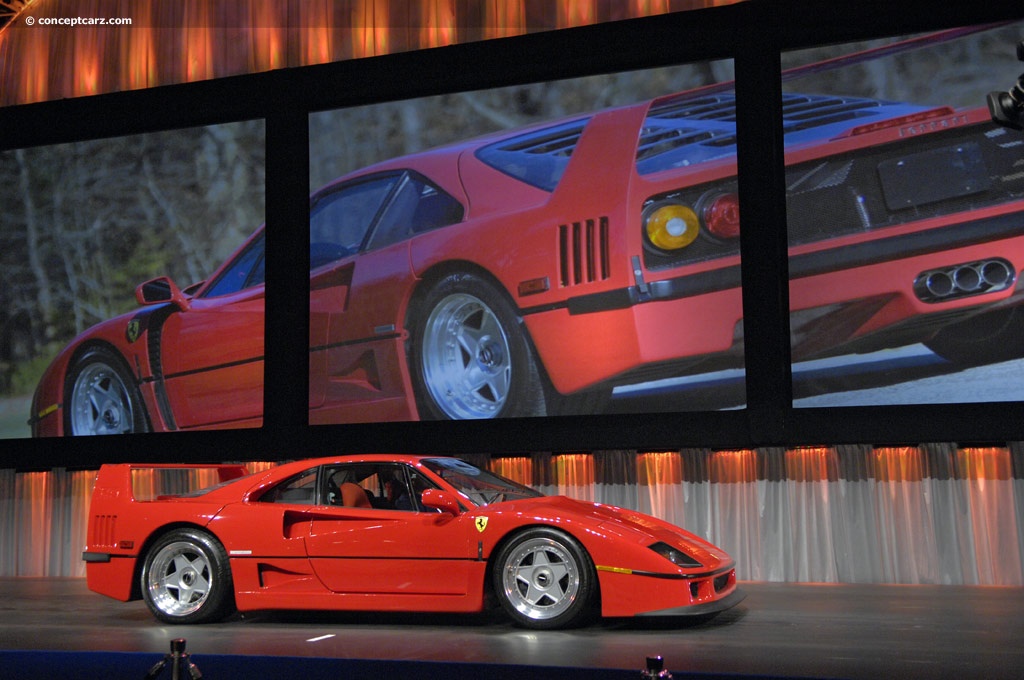
Coupe
Chassis #: ZFFMN34A9M0087511
Engine #: 04561
Auction entries : 1
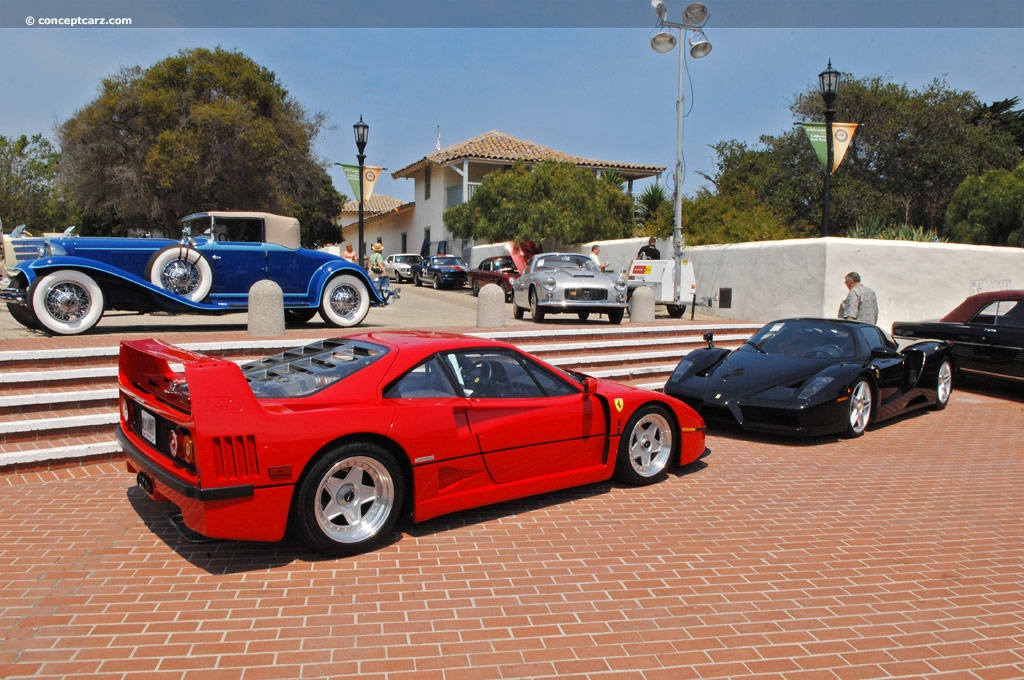
Coupe
Chassis #: ZFFMN34A0M0089888
View info and history
Auction entries : 1
Displacing 2,936 cubic centimeters (2.9-liter / 179.2 cubic-inch) and fitted with twin IHI turbochargers and Behr intercoolers, the mid-mounted engine developed a stout 478 horsepower at 7,000 RPM and 425 pound-feet of torque at 4,000 RPM. It had a bore size of 82 mm, a stroke of 69.5 mm, 7.7:1 compression, and a unitary displacement of 367 cc. There were dual overhead camshafts per bank, four valves per cylinder, and Weber-Marelli electronic fuel injection with single spark plug ignition per cylinder. Exhaust gases exited each bank of cylinders via flanking exhaust pipes, and a central pipe dispersed gases released from the wastegate of the turbochargers. A catalytic converter was installed in 1990 to comply with U.S. regulations for emissions control reasons.
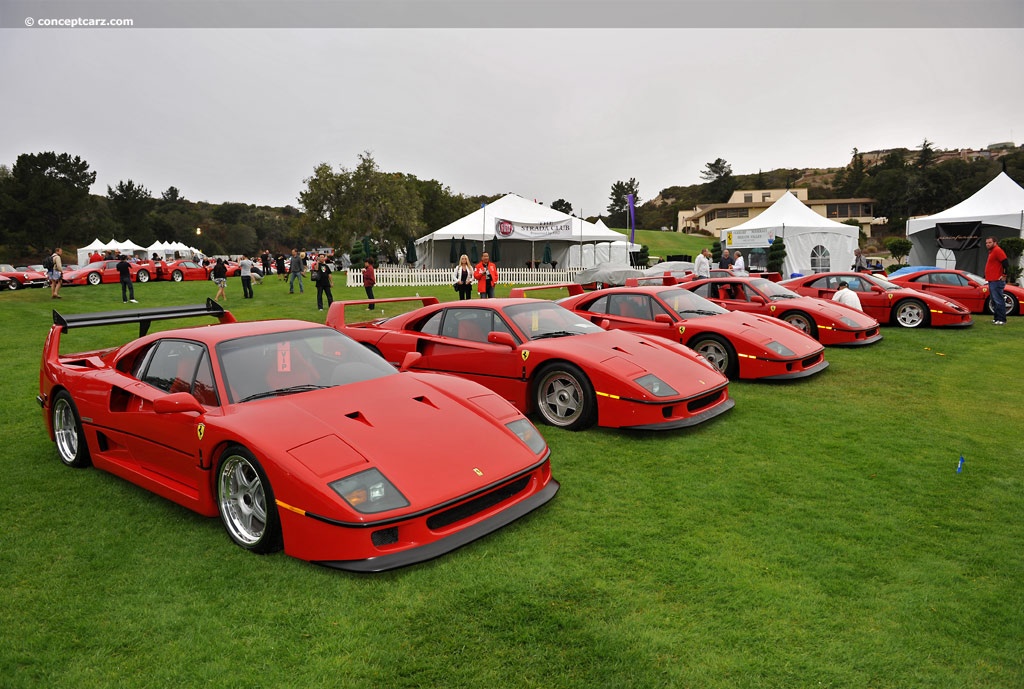
Coupe
The angular bodywork was penned by Pietro Camardella under supervision by Pininfarina's stylists Leonardo Fioravanti and Aldo Brovarone, and aerodynamically perfected in Pininfarina's wind tunnel. It featured a massive spoiler wing that was a consummate study in 1980s wedge angularity. Through extensive wind tunnel testing, the shape was perfected and eventually incorporated a host of NACA ducts throughout its surfacing. A partial undertray smoothed airflow beneath the radiator, front section, and the cabin, and a second one with diffusers behind the engine.Weight reduction was paramount, with the bodywork formed from a Formula 1-derived lightweight weave of Kevlar and carbon fiber. Bonded to the tubular chassis, it created a lightweight structure of immense rigidity. The overall shape achieved a commendably low drag coefficient of just 0.34. Weight-saving measures continued in the interior, with body-contoured cloth upholstered plastic-composite racing seats, pull-strap door releases, an absence of carpeting and trim, drilled pedals, and sliding Perspex windows in the first fifty examples. Later built examples had roll-up windows. The windshield was built from polycarbonate plastic. Motorsports
Chassis number 79890 and 79891 made their racing debut in 1989 at the Laguna Seca Raceway round of the IMSA, appearing in the GTO category. They were joined by a third car, chassis number 88521, which served as a spare. The cars had been prepared by Ferrari specialist Michelotto who had previously worked on the factory's GTO Evoluzione. Jean Alesi drove one of the LM evolution models to a third-place finish at Laguna Seca Raceway, outpacing many other factory-backed racecars. It retired after eighteen laps at its next race. During the next IMSA season, the LM was piloted by several drivers, such as Jean-Pierre Jabouille, Jacques Laffite, and Hurley Haywood, earning three second-place finishes and one third-place.The F40 did not compete during the 1991 IMSA season. Instead, privateers competed in domestic GT series, including JGTC. In 1994, one example campaigned in the BPR Global GT Series by Strandell, winning at the 4 Hours of Vallelunga. In 1995, four examples, developed independently by Pilot-Aldix Racing (F40 LM) and Strandell (F40 GTE) competed in international competition, with accolades that included a victory in the 4 Hours of Anderstorp. Another victory at Anderstorp was achieved a year later, but by this point, it had been outclassed by the newly entered McLaren F1 GTR. F40 Competizione
A French importer wanted to race the F40 at the 24 Hours of LeMans, birthing a more powerful version of the F40 LM. A total of ten examples were eventually built to customer requests, with the first two being dubbed F40 LM, and the remaining eight being F40 Competizione. The engine was tuned to produce nearly 700 horsepower (691 hp) at 8,100 RPM and had a top speed of approximately 228 mph (367 km/h).
by Daniel Vaughan | Jul 2023
Related Reading : Ferrari F40 History
The F40 was the last car introduced and commissioned by Enzo Ferrari himself. Its introduction and its name coincided with Ferraris 40th anniversary as an automobile constructor. The car was a celebration of the marque and the man seeking to safely provide owners with a race car for the street, embodying all the finest elements of 1987 automotive engineering. The F40 was to a large extent an evolution....
Continue Reading >>
Continue Reading >>
Related Reading : Ferrari F40 History
1987 was Ferraris 40th anniversary of the first Ferrari. A year prior, the Ferrari team had been commissioned to design and build a car to pay tribute the companys long and distinguished past. Enzo Ferrari said, Build a car to be the best in the world. The result was one of the greatest supercars to ever travel the roadways. It was a brilliant vehicle, had a futuristic design, and was void....
Continue Reading >>
Continue Reading >>
Related Reading : Ferrari F40 History
A mid-engine, rear-wheel drive, the Ferrari F40 is a two-door coupe sports car produced by Ferrari from 1987 until 1992. The F40 was the successor to the Ferrari 288 GTO. The F40 held a prestigious reputation as the worlds fastest street-legal production vehicle from 1976 until 1989. During its years of production, the F40 was Ferraris most expensive, fastest and most powerful car. The F40 was....
Continue Reading >>
Continue Reading >>
Similar Automakers
1991 Ferrari F40 Vehicle Profiles
Recent Vehicle Additions
Performance and Specification Comparison
Price Comparison
$122,180
$161,600
$161,605
F40 Specification Comparison by Year
Year
Production
Wheelbase
Engine
Prices
Related Automotive News

GTO Legacy Tour 2024 – A journey through the Dolomites in celebration of an icon
Ferrari will celebrate the 40th anniversary of its first supercar in October with the GTO Legacy Tour 2024
The GTO event is the second Legacy Tour, following the debut rally a year ago for the F40
The stunning passes and breath-taking scenery of...

Ferrari Museum Celebrates Scuderia Ferrari's Landmark Anniversary With The '90 Years Exhibition'
Hypercars the story of Ferraris technological evolution told through milestone cars
Maranello, xx May 2019 – One of the great iconic names in motorsport with the power to unite an entire country and millions of fans from all over the...

30th Anniversary Of The F40
Maranello, 21 July 2017 - Thirty years have passed since the official presentation of the F40, which took place on 21 July 1987 at the Civic Centre in Maranello, now home to the Ferrari Museum. Created to celebrate the companys 40th anniversary,...

HONDA NSX SUPERCAR MAKES EUROPEAN DEBUT
All-new model delivers a ground-breaking New Sports eXperience
Designed from a clean-sheet with an Interwoven Dynamic exterior design and uncompromising focus on driver control, visibility and packaging inside
New all-wheel drive hybrid powert...

The myth of the auction room
Who will be the lucky new owner of the 1967 Le Mans winner
Maranello, 2th January 2015 – The new year begins with a celebration of the past. On January 15th, the most eagerly-awaited car at the Bonhams sales in Scottsdale goes under the...




















